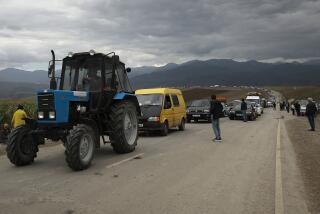Armenian Group Distributes Curriculum Guide on ‘Forgotten Genocide’
A Glendale-based Armenian organization has begun distributing the first English-language curriculum guide to teach about what Armenians call “the forgotten genocide”--the killings of more than a million Armenians by the Ottoman Turkish regime.
The guide was published by a branch of the Armenian National Committee, one of several Armenian-American political organizations with offices in the Los Angeles area. The handbook is a suggested lesson plan for teaching about the deaths, which occurred between 1915 and 1923.
Titled “The Armenian Genocide,” the guide evolves from more than half a century of attempts by Armenian groups to establish the deaths to the American public as an example of genocide, which is defined as the systematic killing of a national or ethnic group.
It is unclear at this time whether teachers will use the material.
The nature and intent of the deaths have long been the subject of fierce and often violent disagreement.
Armenian scholars say that Talat Bey, then interior minister of the Ottoman Empire, explicitly ordered a mass killing of Armenians in 1915. The Turkish government says there was never a calculated plan of extermination.
Turkish officials do not deny that many Armenians were killed by Ottoman Turks during World War I, but they put the number of deaths at closer to 300,000. They contend that Armenians killed about as many Turkish Muslims during the period.
Scholar Disputes Genocide
“I dispute that there was a genocide of Armenians. I don’t believe that is an appropriate term for what was a combination of international war, an inter-communal war and especially death from starvation and disease,” said Justin McCarthy, a Mideast scholar and author of several books on the Ottoman Empire who is chairman of the department of history at the University of Louisville, in Kentucky.
“It would be proper to present both sides of the contentious historical issue, but they have deliberately not done that. They have deliberately picked the one side that is most politically expedient.”
Armenian scholars say that the massacre is beyond dispute.
California Department of Education officials said last week that the decision whether to use study materials prepared by independent groups is left to school districts and in many cases to individual teachers.
Vic Pallos, a Glendale school district spokesman, said that district officials have not yet had time to assess the curriculum guides.
The 84-page handbook is illustrated with stark pictures of victims and bedraggled survivors. It details the history of the Armenian people, the deaths that the community continues to mourn and the result--the scattering of Armenians around the globe.
The guide was written by Garine Zetlian, a 27-year-old doctoral candidate in Armenian and Mideast history at UCLA. Zetlian said she researched both Turkish and Armenian archives in preparing the handbook and received assistance from Armenian scholars nationwide, including Richard Hovanissian, a UCLA professor who is regarded as a national authority on Armenian history.
“Genocide in general and the Armenian genocide in particular have fallen out of textbooks of recent history and civilization,” Hovanissian said. “We want to motivate teachers to devote a couple of weeks to this subject in an otherwise very crowded curriculum.”
The guide is one of several study aids prepared by Armenian organizations to accompany the “Model Curriculum for Human Rights and Genocide,” which was ratified by the State Board of Education in October, 1987. The development of the model curriculum was mandated by the California Legislature in 1985, after years of intensive lobbying by Armenian and Jewish organizations and other minority groups.
Under the guidelines prepared by the state Department of Education, California’s school districts in 1988 began adding “human rights with particular attention to the inhumanity of genocide” to the regular social studies curriculum of students in the seventh through 12th grades.
The curriculum includes, in addition to the Holocaust and the deaths of the Armenian people, a discussion of the Ukrainian famine brought on by Soviet agricultural policies in 1932-33, the mass murder of Poles during World War II, slavery in the United States, recent human rights abuses in Argentina, Cambodia and South Africa and discrimination suffered by Asians, Latinos, women, the handicapped, gays and Native Americans.
“For someone who doesn’t have any idea who the Armenians are or where they come from, the handbook offers a more elaborate presentation of who we are and the genocidal process,” Zetlian said. “Our hope is that educators will familiarize themselves with the document and decide to use it in the classroom.”
Zetlian said she sought suggestions from curriculum planners and teachers to develop the guide, which includes maps, vocabulary lists, suggested questions, puzzles and an extensive bibliography.
Completed in December, more than 300 complimentary copies of the guide have since been sent from the Armenian National Committee branch on Colorado Boulevard to schools throughout Southern California, where more than 250,000 Armenians live. Committee officials said they plan to distribute the book nationally, but will charge $10 a copy.
The Armenian Assembly, a political organization with offices in Hollywood, is also distributing study materials about the Armenian deaths to California educators. The Assembly’s publication--also being distributed for free--is an extensive bibliography of documentation and secondary sources about the genocide, rather than a lesson plan.
In teaching about the deaths of their people, Armenian community leaders and outside scholars agree that they are following the example of American Jews, who have for years produced an enormous reservoir of educational material to teach about the Holocaust.
“When the Holocaust began to be talked about, it was first by Jewish survivors, and it took Jewish scholars to bring to the fore the specifics of the Holocaust and its place in history,” said Margot Strom, director of Facing History in Ourselves.
More to Read
Sign up for Essential California
The most important California stories and recommendations in your inbox every morning.
You may occasionally receive promotional content from the Los Angeles Times.









